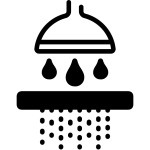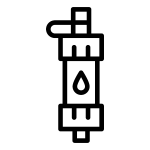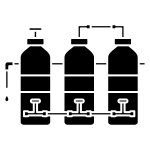Brushed nickel faucets are a timeless addition to modern bathrooms and kitchens. Known for their soft metallic finish, resistance to fingerprints, and sleek appearance, they blend style and practicality. But even the most durable fixtures need regular maintenance to stay beautiful and functional. So, how do you clean brushed nickel faucets without damaging their finish?
In this comprehensive guide, we’ll walk you through the best practices, cleaning solutions, tools, common mistakes, and tips to keep your brushed nickel faucets sparkling clean. Whether you’re maintaining your bathroom faucet, kitchen sink, or luxurious bathtub fixture, this guide from Cuoll—your go-to store for water filters, purifiers, and home essentials—will help you do it right.
📌 What Is Brushed Nickel?
Before diving into cleaning techniques, it’s essential to understand what brushed nickel is. Brushed nickel is a type of metal finish created by brushing the surface of nickel-plated faucets with a wire brush or abrasive pad. This results in a matte, slightly textured appearance that helps hide water spots and fingerprints better than chrome or polished finishes.
🟢 Why People Love Brushed Nickel Faucets:
- Low maintenance – resists smudges and spots
- Neutral appearance – matches most bathroom and kitchen styles
- Durability – corrosion- and rust-resistant
- Timeless aesthetic – doesn’t go out of style quickly
However, brushed nickel can still tarnish or corrode if not properly cleaned or maintained.
🧽 How Do You Clean Brushed Nickel Faucets? A Step-by-Step Routine
Cleaning brushed nickel doesn’t have to be complicated. Here’s a routine you can follow weekly or bi-weekly to maintain that clean, elegant look.
✅ Step 1: Gather Your Supplies
You don’t need harsh chemicals. In fact, brushed nickel is sensitive to abrasive cleaners. Here’s what you need:
- Soft microfiber cloth or sponge
- Mild dish soap
- Warm water
- White vinegar (optional for hard water stains)
- A soft toothbrush (for crevices)
- Baking soda (for deeper cleaning)
- Olive oil or baby oil (for polishing)
✅ Step 2: Daily Wipe-Down (Optional but Recommended)
After every use, quickly wipe the faucet down with a dry microfiber cloth. This helps remove water spots and prevents calcium build-up over time, especially if you have hard water.
✅ Step 3: Weekly Cleaning Routine
- Mix warm water with a drop or two of mild dish soap.
- Dip a soft cloth or sponge into the soapy water.
- Gently wipe down all surfaces of the faucet, including handles, base, and joints.
- Use a soft toothbrush to scrub around tight areas or crevices.
- Rinse with clean water to remove soap residue.
- Dry thoroughly with a soft towel or microfiber cloth to avoid water spots.
✅ Step 4: Dealing with Hard Water Spots and Mineral Deposits
If you live in an area with hard water, you may notice chalky white deposits forming around the base or handles of your faucet.
Here’s how to handle it:
- Mix equal parts of white vinegar and water in a spray bottle.
- Spray the affected area and let it sit for 5–10 minutes.
- Use a soft toothbrush or cloth to gently scrub the area.
- Rinse thoroughly and dry completely.
🚫 Important: Never let vinegar sit on the faucet for too long, and never use it undiluted on brushed nickel, as it can corrode the finish.
🧴 How to Deep Clean Brushed Nickel Faucets (Once a Month)
For a deeper clean to tackle grime, soap scum, or build-up, use baking soda paste:
How to Make the Paste:
- 2 tablespoons of baking soda
- Enough water to make a thick paste
Apply and Clean:
- Spread the paste on problem areas.
- Let it sit for 10–15 minutes.
- Scrub gently using a soft cloth or toothbrush.
- Rinse and dry thoroughly.
✨ How to Polish Brushed Nickel Faucets
Want your faucet to really shine?
- Take a small amount of olive oil or baby oil on a soft cloth.
- Gently buff the faucet in the direction of the grain.
- Wipe away excess oil with a dry microfiber towel.
This not only brings back the faucet’s natural sheen but also adds a protective layer to repel water spots and fingerprints.
❌ What to Avoid When Cleaning Brushed Nickel
To preserve the finish of your brushed nickel fixtures, avoid the following at all costs:
🚫 Abrasive Cleaners
- Scouring powders or cream-based scrubs
- Steel wool or rough sponges
🚫 Acidic Cleaners
- Undiluted vinegar
- Lemon juice
- Any cleaner labeled “acidic” or “degreaser”
🚫 Bleach or Ammonia-Based Products
These are too harsh for brushed nickel and can cause pitting or discoloration.
🚫 Leaving Water on the Surface
Water can cause mineral deposits over time. Always dry the faucet after cleaning or heavy use.
🔄 Quick Cleaning Schedule for Busy People
| Frequency | Task |
|---|---|
| Daily | Wipe with dry microfiber cloth |
| Weekly | Clean with dish soap + warm water |
| Monthly | Deep clean with baking soda paste |
| Quarterly | Light polish with olive or baby oil |
🛀 Bonus: How to Clean Brushed Nickel in Bathtubs and Shower Fixtures
If you’ve purchased bathtub faucets or shower fixtures from Cuoll, you might be dealing with larger surfaces. The same principles apply, but here are a few tailored tips:
- Use a long-handled sponge or soft brush for high or hard-to-reach areas.
- Rinse thoroughly after every shower to minimize soap scum.
- Install a water softener or use a shower filter (available at Cuoll) to prevent hard water damage.
💡 Pro Tip: Prevent Faucet Build-up with a Water Filter
Hard water is the #1 enemy of brushed nickel, causing mineral build-up and damage over time. One of the best ways to protect your investment is by installing a high-quality water filter or softener.
At Cuoll, we offer:
- Shower filters to reduce chlorine and lime scale
- Faucet filters for clean, filtered water
- Whole-house water purification systems
By reducing hard minerals in your water, you’ll:
- Prevent spotting and build-up
- Extend the life of your plumbing fixtures
- Enjoy healthier skin and hair
🛒 Browse Water Filters at Cuoll →
🔧 When to Replace or Repair Brushed Nickel Faucets
Even the best faucets eventually wear out. If you notice any of the following, it may be time for a replacement:
- Peeling or pitting on the finish
- Leaking or dripping despite cleaning
- Loose handles or worn-out components
- Irremovable hard water stains
Explore Cuoll’s premium range of brushed nickel faucets, bathtubs, and water purifiers to upgrade your bathroom experience.
📦 Best Products from Cuoll for Faucet Maintenance
| Product | Use |
|---|---|
| Water Filter | Prevents mineral build-up in faucets |
| Faucet Cleaning Kit | Includes microfiber cloths, safe cleaners |
| Bathtub Cleaner | Safe on nickel finishes |
| Replacement Faucet Parts | In case of leaks or damage |
🛒 Shop all your faucet care needs at Cuoll – where home care meets quality!
📌 Final Thoughts: Keep Your Brushed Nickel Faucet Looking Like New
So, how do you clean brushed nickel faucets? The secret lies in gentle, consistent care using the right tools and avoiding harmful chemicals. Whether you’re maintaining a sleek kitchen sink, a spa-inspired bathtub faucet, or a high-end shower fixture, following these simple steps will help protect your investment and enhance your space’s aesthetics.
💧 And don’t forget — using a quality water filter from Cuoll not only benefits your skin and health but also keeps your brushed nickel shining brighter for years to come.







